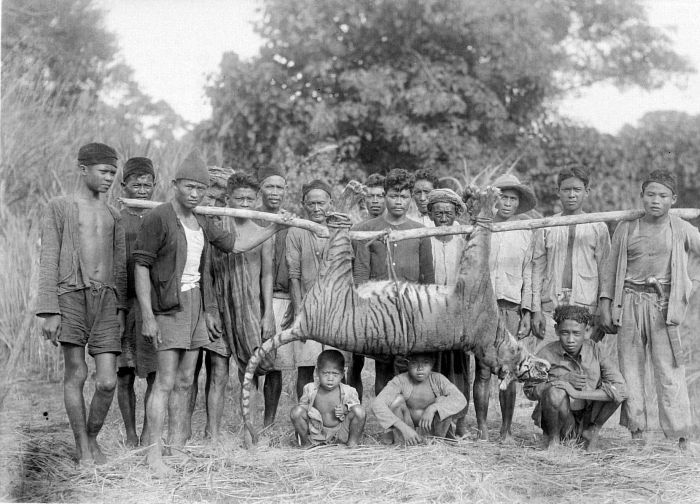Tiger is among the most recognisable and popular of the world’s charismatic megafauna. There were 100,000 wild tigers just over a century ago and now there are only 4,500 tigers. Major reasons for population decline are habitat destruction, fragmentation and climate change. Tigers are also victims of human–wildlife conflict, due to encroachment in countries with a high human population density. However, the biggest single cause of population decline, is tiger poaching.

Poaching has been defined as the illegal hunting or capturing of wild animals. This is often done to fuel the illegal wildlife trade. Tigers, leopards, rhinos and elephants are major victims of this trade. Tigers are traded as trophies or for their skin, teeth, nails, paws and in rare cases for their meat.
Tiger Poaching is highly lucrative
Tiger poaching is still a hot topic because of the profit these poachers and whole trafficking chain makes. Most of the illegal trafficking of animal’s land in China. Recent interest in traditional folk medicines, often referred to as Traditional Chinese Medicine, from China and Southeast Asia has kept tiger poaching profitable in recent decades. Many cultures in Asia have a long history of believing the tiger has supernatural or restorative powers, making the animals valued for their essentially all of their parts. Tiger skins have a strong value to traditional Buddhist monasteries but also to contemporary Asian celebrities who have worn the skins as provocative status symbols.
A report by the Environmental Investigation Agency (EIA) from 2004 indicated that tiger skins were being sold for up to $10,000 in Tibet primarily to Chinese, Taiwanese, and European tourists. Teeth and claws also have a special importance to buyers as a status symbol. According to latest reports a single tiger skin can be sold around $55,000 at global market. Tiger bones are also highly sought after for use in medicines and health tonics and in the past few years tiger bone wine has become a curiosity, despite being illegal. According to Walker’s Mammals of the World a tiger skin could sell for approximately $4,250 in 1977, about $16,880 in 2015 dollars.
Trends in Tiger Poaching
In October of 2003 the Environmental Investigation Agency (EIA) reported that a shipment of skins from 581 leopards, 31 tigers, and 778 otters heading from India to Lhasa, Tibet had been intercepted at the border. An incident in July of 2004 in Kanpur, India saw the seizure of 456 leopard and tiger claws and $13,000 in cash. The report, “Skin and Bones: Tiger trafficking analysis from January 2000 to June 2022,” showed a total of 3,330 tigers were illegally confiscated globally during this timeframe. Out of this number, 893 of the tigers were seized in India, which is home to more than half of the global wild tiger population.
Tiger parts are also being sourced from Czech Republic, and other countries inside the European Union, and are destined for Southeast Asia. In spite of China’s ban of the tiger parts trade there are still incidents of tiger parts being sold to consumers. While China is thought to once the largest populations tigers, the country is now home to very few wild tigers and thousands held in captivity for amusement or farming. Today India is thought to have among the largest wild tiger populations, however this accounts for only the Bengal subspecies
Tiger skin is the most sought-after part of the animal, along with claws and teeth. Out of the global total, 38% of tiger skins, and 42% of claws and teeth, were seized in India, the report showed. And social media is playing a role in both illegal sales and in law enforcement investigations into wildlife trafficking and in late 2014 a pair of online merchants were arrested in Indonesia for attempting to sell a number of stuffed tigers, lions, and bears.
What are tiger body parts used for?
- Tiger skins are turned in to rugs or stuffed and used as luxury home décor. Such displays of wealth are thought to symbolise power and wealth in some cultures.
- Tiger bones are used to make “bone strengthening wine”. In China this is often a tonic (with unproven health benefits) and as a prestigious gift.
- In Traditional Chinese Medicine, tiger bone wine has been used for over 1000 years, believed to cure a range of ailments, including arthritis and eczema.
- Tiger claws and teeth are widely used as amulets or trinkets across the globe.
Among Chinese consumers in Laos, tiger bone wine is marketed as a virility product for men (scientific research shows no effect on virility). Even though the Chinese government banned the trade and use of tiger parts in 1993, the strong cultural belief in the medicinal power of tiger parts means there is continued demand, fuelling black market trade. In Traditional Chinese Medicine a tiger’s penis is believed to be a natural enhancer of male virility and in 2006 a dish sold for $5,700 in Beijing (about $6,800 in 2015).
The demand for wild tiger skins, bones, parts, and derivatives makes illegal poaching & wildlife crime, without a doubt, the biggest and most concerning threat that the world’s remaining wild tigers face.
Written by: Atharv Deshmukh
Help us Help Them! Think Wildlife Foundation is a non profit organization with various conservation initiatives. Our most prominent campaign is our Caring for Pari intiative. Pari is a rehabilitated elephant at the Wildlife SoS Hospital. 25% of the profits from our store are donated to the elephant hospital for Pari. Other than buying our wonderful merchandise, you could donate directly to our Caring For Pari fundraiser.
